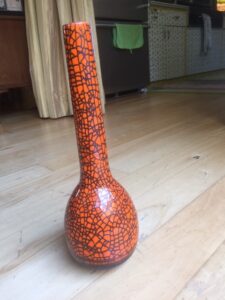 Don’t let this tall orange ceramics vase with black crazing fool you. It’s NOT Asian, but a Hungarian vase. Geza Gorka, born in 1894 in Slovakia, created this vase. He studied, after choosing ceramics as his life work, in Lentkirchen, Germany, with masters Paul Mann and Mas Laeuger. They taught him the chemistry and physics of the potter’s art.
Don’t let this tall orange ceramics vase with black crazing fool you. It’s NOT Asian, but a Hungarian vase. Geza Gorka, born in 1894 in Slovakia, created this vase. He studied, after choosing ceramics as his life work, in Lentkirchen, Germany, with masters Paul Mann and Mas Laeuger. They taught him the chemistry and physics of the potter’s art.
Gorka learned the necessary heat ratios, and high firing techniques of art pottery, and the art of cracked glazes, going back to the Asian styles developed through thousands of years. At least two forms of crazing exist. One is to form a series of cracks inside of the pottery, called craquelure. Another forces the glaze itself to create the hairline cracks. Both techniques are difficult to accomplish because many a young potter’s pieces end up shattered as they learn the art of perfected imperfection, the art of crazing!
Crazy for Crazing
We see on this vase a series of craquelure, in fact an applied glaze, not the typical crazing IN the ceramic itself. Potters loved the accidents of a glaze, which became the art of crazing, when it chemically doesn’t bind to the ceramic. Asian potters deliberately tweaked the chemicals used in glazing and heat processes to “crack” a glaze. Sometimes it formed intricate spiderweb designs which took years to learn.
Also a tradition in Japanese Wabi-sabi, an aesthetic of imperfection, calls for ceramic objects to shatter and become re-worked with a paste to reconstitute. The beauty of the pieces, called Kintsugi, shows in the natural stress patterns of the break points emphasized by the paste used to glue the piece back together.
Aesthetics of imperfect/perfect art formed the basis for the theory of deliberate crazing on a ceramic vessel, usually accomplished at a very high heat. But the potter made the glaze appear like deep cracks, and they applied a second glaze. Gorka did that on this Hungarian vase.
Hungary: Hotbed of Ceramic Talent
Hungary in the early to mid-20th century became a hotbed of ceramic talent. Most notably the Zsolnay Manufactory, beloved by Art Nouveau collectors, also a major manufacturer of tiles and decorative ceramics used in architecture. Anyone who visited Budapest saw these features. Zsolnay, the largest company in Austro-Hungary in 1914, produced decorative tiles and mask-from grotesques of Zsolnay ceramics seen all over the early 20th century buildings of Budapest. The war stopped the production, and the government ordered the factory to create insulators.
Previous to that two special glazes were developed and kept secret. Artists at the factory took these secrets and expanded upon the chemicals and heat needed to create further experimentation in glazing. Geza Gorka was one of those talented artists who came out of the experimentation. From 1946 to 1948 he headed experimentation for high fired vessels at Zsolnay workshop. Midcentury Modern collectors call him one of the founders of modern Hungarian ceramic art. His work typifies simple lines, bold colors, influenced by German Expressionist paintings and woodcuts, folk styles of Hungary, and the geometric shapes of art Deco.
For years, he served on the directorial board of the Association of Hungarian Designers. He made hundreds of art pottery pieces, but also functional ceramic objects for architecture. He became a beloved teacher at the Zebegeny Free School in 1970. When he died in 1971 his home was named a museum, The Gorka Ceramics Museum.
Hungarian Vase Change in Value
Thrift store shopping in the 1990s, I saw a lot of this Hungarian pottery, in the Mid Century style. I thought it amateurish and too clunky to be worth purchasing for the $5 price tag on most of them. The colors were too strong, the forms too simple, and the designs too geometric. How things change, especially in the history of design. For the reasons I did not like the Hungarian vase “look,” Midcentury modern collectors today LOVE those very same design features. What I could have picked up for $5 is now worth $500 or more today, as is GH’s vase.
Pingback: Midcentury Modern Kitsch Chalkware Lamp - Elizabeth Appraisals